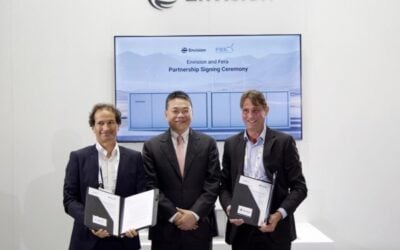The new RMI report looks at “load defection,” meaning that customers who install PV and batteries remain connected to existing networks and infrastructure, rather than wholesale “grid defection”. Image: STEM Inc.
Pairing solar with grid-connected batteries is likely to become the most economically attractive option for residential and commercial customers in key US markets between now and 2040, a new report says.
The study from the Rocky Mountain Institute (RMI) says that compared to either relying on retail electricity from the grid or going completely off grid, grid-connected solar plus storage will become the most popular choice in some areas, relegating centrally generated power to as little as 3% of load provision by 2040.
Enjoy 12 months of exclusive analysis
- Regular insight and analysis of the industry’s biggest developments
- In-depth interviews with the industry’s leading figures
- Annual digital subscription to the PV Tech Power journal
- Discounts on Solar Media’s portfolio of events, in-person and virtual
The RMI, which seeks market-based solutions to questions of sustainability, has published ‘The economics of load defection’, a report which examines through to 2050 the potential for customers to choose solar and storage in five key regions of the US. The report is authored by the RMI team with a number of other contributors, while energy modelling was done using software by Homer Energy.
RMI’s latest report also quotes recent analysis and notes from financial institutions including Barclays, UBS, Morgan Stanley, Bank of America, Citigroup and Goldman Sachs, which have all highlighted the strongly disruptive threat to utility business models posed by solar-plus-storage. Last year, RMI says, “a chorus of analyses from major financial institutions… found that solar-plus-battery systems pose a real and present threat to traditional utility business models”.
By around 2040, the report claims, customers could be sourcing a majority of their load from onsite PV using storage, with the grid restricted to providing between just 3% and 25%, in New York, Texas and California. At present around 80% and 100% of customer load is provided by the grid even in those regions, which have a relatively high level of renewable energy penetration already by current standards.
The high likelihood of prices for grid connected electricity to continue rising will mean that a solar PV system with a connected battery will increasingly mean a good investment, the report says. Meanwhile, customers who buy all their electricity from the grid will face the pressure of those rising prices and customers who choose to go completely off-grid will be faced with the high capital cost of installing solar and storage in a standalone configuration.
Additionally, customers who install solar-plus-batteries could also confer benefits to the grid and its operators, allowing for deferral of spending on infrastructure updates and other costs. Storage systems could also relieve grid congestion and provide ancillary services. Updating the grid infrastructure could require as much as an average US$100 billion a year across the US, RMI argues.
One caveat to this last point is that new business models will have to be sought out to capture the true value of the storage systems, which at present are not recognised for providing this kind of value to the grid in most of the US.
Some of the biggest solar companies including SunPower and SolarCity have advocated for a collaborative future for solar, batteries and the grid for some time. Image: SunPower.
The report may not be greeted as great news by everyone. Those with a stake in old-fashioned centralised generation and transmission, including independent power producers and merchant power plants, might find their electricity revenues eaten into by new fleets of solar-plus-storage systems. The fast acting battery devices could also take a good portion of the market for ancillary services, often provided by combined cycle gas peaker plants in the US. Companies could be left with a “real risk” of stranded assets, RMI says.
Similarly, utility companies will need to reconfigure their business models and find new ways of doing business in the face of the obvious threat.
Just in the past few days, a large utility in Arizona has pleaded to the state’s regulator to raise fees charged to residential PV system operators for use of the grid. Arizona Public Service (APS) has asked the Arizona Corporation Commission (ACC) to hike up from US$0.70 per installed kW to US$3 per installed kW a set of charges levied on residential customers with rooftop solar. APS argues that all customers use the grid to some extent and that non-solar customers are paying for the grid use of their solar counterparts.
Supporters of residential solar in Arizona, including advocacy groups and solar installation companies, have countered the argument in part by asking for the benefits of solar to be better recognised. One representative of the Solar Energy Industries’ Association (SEIA), said at the time that utilities should innovate around their business models to survive. Protests around the case last year were attended by an estimated crowd of 1,000.
Last year RMI caused a stir in some circles with a previous report, “The economics of grid defection”. Published in 2014, it looked at the phenomenon of solar-plus-storage in a similar way, the crucial difference being that last year’s report looked at full-on defection from existing grid networks, in other words the feasibility of individual customers “islanding” themselves by going off-grid.
This time around, RMI is arguing that it makes more sense for customers and grid operators to go solar, to add batteries, but to remain on the grid nonetheless. This chimes with a broad cross section of industry opinion, with top level representatives of companies including SolarCity and SunPower advocating for their part in a collaborative future with utilities and grid operators, especially when it comes to adding batteries to PV systems. Customers can use their own solar-generated power while retaining the benefits of the uninterruptible power from the grid, while grid operators could use the customers’ batteries to add resilience and flexibility to the network.
The report looks at detailed analysis of cost and pricing, as well as offering forecasts, for key drivers of the energy storage market including lithium-ion battery production and EV sales. It examines five US regions: Honolulu in Hawaii, California’s Los Angeles County, San Antonio in Texas, Louisville in Kentucky and New York’s Westchester County. The report can be downloaded in full from the Rocky Mountain Institute’s website.






